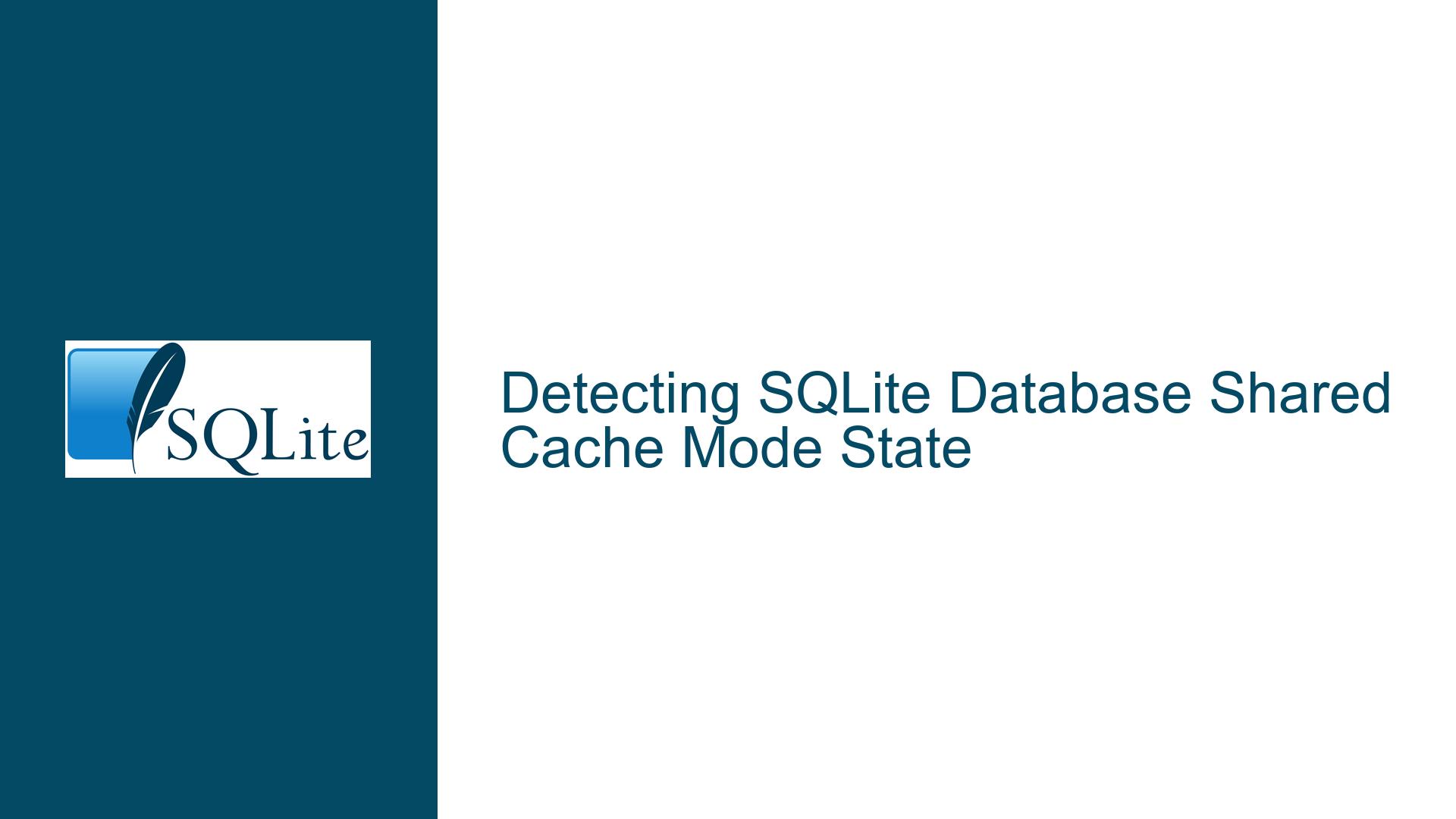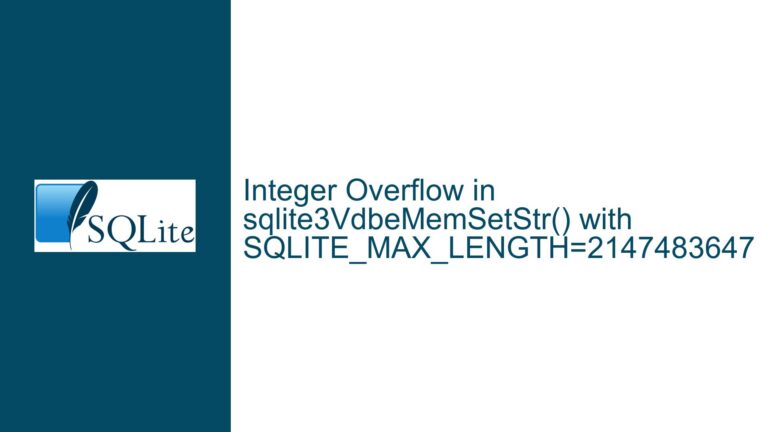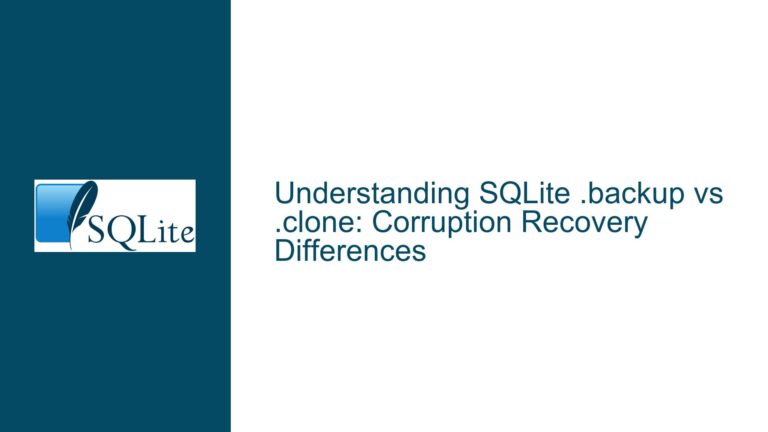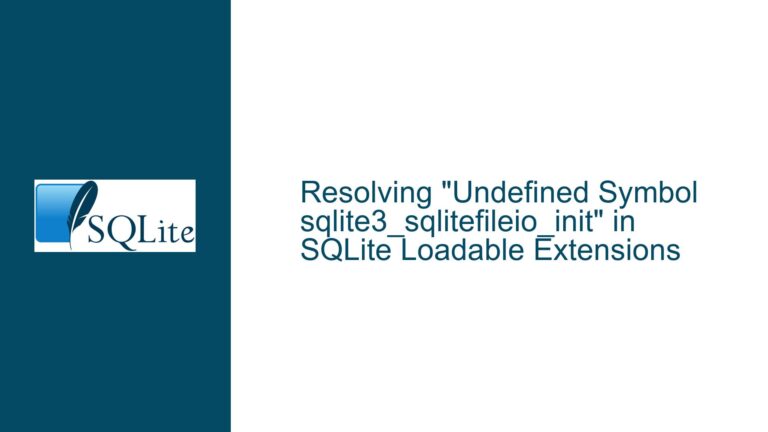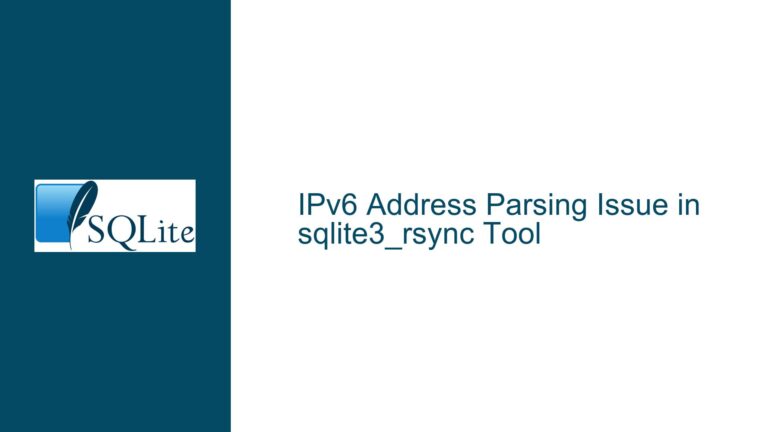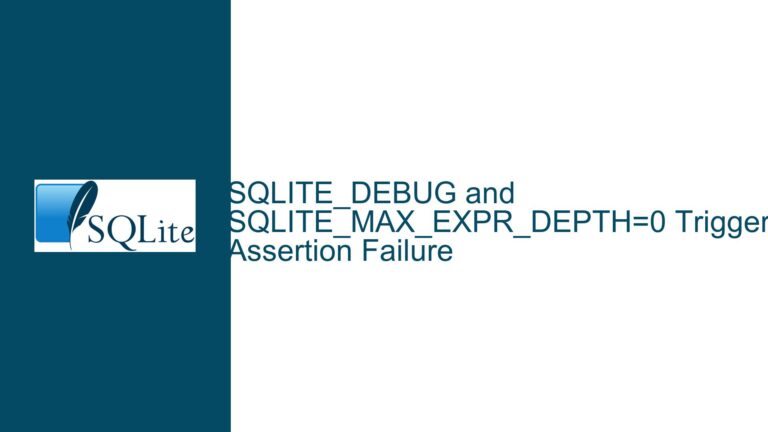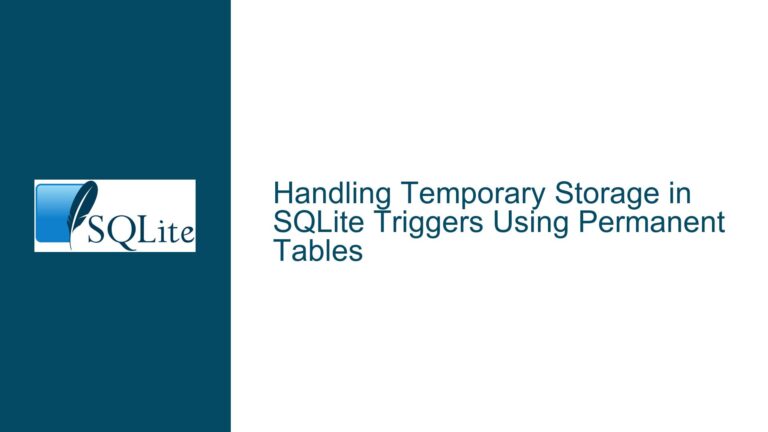Detecting SQLite Database Shared Cache Mode State
SQLite Shared Cache Mode: Absence of Query Interface
SQLite’s shared cache mode is a legacy feature originally designed to address concurrency needs on SymbianOS devices. This mode allows multiple database connections to share a single cache, reducing memory usage and improving performance in specific scenarios. However, SQLite does not provide a built-in interface to query whether a database was opened in shared cache mode or to determine the global shared cache setting. This absence of a query interface has been a point of confusion for developers who rely on shared cache mode or need to debug its usage.
The shared cache mode can be enabled globally using the sqlite3_enable_shared_cache function or on a per-connection basis using URI parameters or open flags. Despite these configuration options, there is no direct way to programmatically check the current state of shared cache mode for an active database connection. This limitation stems from the fact that shared cache mode is considered a legacy feature, and the SQLite development team discourages its use in favor of Write-Ahead Logging (WAL) mode, which offers better concurrency and performance in modern applications.
The lack of a query interface for shared cache mode is intentional. The SQLite development team views shared cache mode as a "misfeature" and has chosen not to extend its functionality. Instead, they recommend using WAL mode, which provides a more robust and scalable solution for concurrent database access. This design decision reflects SQLite’s commitment to maintaining backward compatibility while steering developers toward more modern and efficient practices.
Legacy Design and Discouragement of Shared Cache Mode
The shared cache mode was introduced as a workaround for the concurrency limitations of SymbianOS, a now-obsolete mobile operating system. At the time, shared cache mode provided a way to optimize memory usage and improve performance on resource-constrained devices. However, as technology has evolved, shared cache mode has become less relevant. Modern applications running on multi-core processors with ample memory benefit more from WAL mode, which offers superior concurrency and performance.
The SQLite development team has explicitly stated that shared cache mode is considered a mistake and a misfeature. This stance is reflected in the decision not to provide a query interface for shared cache mode. By omitting this functionality, the team aims to discourage the use of shared cache mode and encourage developers to adopt WAL mode instead. This approach aligns with SQLite’s philosophy of maintaining a lightweight and efficient database engine while avoiding unnecessary complexity.
One of the key reasons for discouraging shared cache mode is its impact on SQLite’s performance and size. Disabling shared cache mode reduces the size of the SQLite library by approximately 1% and improves performance by around 0.3%. These gains may seem small, but they are significant in the context of SQLite’s design goals, which prioritize efficiency and minimal resource usage. By making shared cache mode an opt-in feature rather than an opt-out one, the SQLite team hopes to further reduce its usage and encourage the adoption of more modern alternatives.
Transitioning to WAL Mode and Best Practices
Given the limitations and discouraged status of shared cache mode, developers are encouraged to transition to WAL mode for concurrent database access. WAL mode provides several advantages over shared cache mode, including better concurrency, improved performance, and reduced risk of database corruption. To enable WAL mode, developers can use the PRAGMA journal_mode=WAL command, which switches the database to WAL mode and enables its associated benefits.
When transitioning from shared cache mode to WAL mode, developers should consider the following best practices:
Evaluate Concurrency Needs: Assess the concurrency requirements of your application. WAL mode is particularly well-suited for applications with high levels of concurrent read and write operations. If your application primarily performs read operations, the default rollback journal mode may be sufficient.
Monitor Performance: After enabling WAL mode, monitor the performance of your application to ensure that it meets your expectations. WAL mode can significantly improve performance in many scenarios, but it is important to verify its impact on your specific use case.
Handle Database Upgrades: If you are upgrading an existing database from shared cache mode to WAL mode, ensure that the upgrade process is handled correctly. This may involve backing up the database, enabling WAL mode, and verifying that the database functions as expected after the transition.
Disable Shared Cache Mode: If shared cache mode is not required, consider disabling it entirely. This can be achieved by omitting the
SQLITE_ENABLE_SHARED_CACHEoption during the build process or by ensuring that thesqlite3_enable_shared_cachefunction is not called in your application code.Use PRAGMA Statements: Leverage SQLite’s PRAGMA statements to configure and monitor database settings. For example, the
PRAGMA journal_modestatement can be used to enable WAL mode, while thePRAGMA synchronousstatement can be used to control the level of synchronization between the database and the disk.
By following these best practices, developers can ensure that their applications benefit from the latest advancements in SQLite’s concurrency and performance features. Transitioning to WAL mode not only improves the efficiency of your database operations but also aligns with the SQLite development team’s recommendations for modern application development.
Implementing PRAGMA journal_mode and Database Backup
To fully leverage the benefits of WAL mode, developers should understand how to implement and configure it using SQLite’s PRAGMA statements. The PRAGMA journal_mode=WAL command is the primary mechanism for enabling WAL mode. When this command is executed, SQLite switches the database to WAL mode, which changes the way transactions are handled and improves concurrency.
In addition to enabling WAL mode, developers should also consider implementing a robust database backup strategy. WAL mode introduces a new set of files, including the WAL file and the shared-memory file, which must be handled correctly during backup operations. The following steps outline the process for enabling WAL mode and performing a database backup:
Enable WAL Mode: Execute the
PRAGMA journal_mode=WALcommand to switch the database to WAL mode. This command should be executed on each database connection to ensure that all connections use WAL mode.Configure Synchronization: Use the
PRAGMA synchronouscommand to configure the level of synchronization between the database and the disk. TheFULLsetting provides the highest level of durability but may impact performance, while theNORMALsetting offers a balance between durability and performance.Perform Regular Backups: Implement a regular backup routine to protect against data loss. SQLite provides the
sqlite3_backupAPI, which can be used to create a backup of the database while it is in use. This API ensures that the backup is consistent and includes all changes made during the backup process.Handle WAL Files: When backing up a database in WAL mode, ensure that the WAL file and the shared-memory file are included in the backup. These files contain critical information about pending transactions and must be handled correctly to ensure the integrity of the backup.
Verify Backup Integrity: After performing a backup, verify the integrity of the backup file using the
PRAGMA integrity_checkcommand. This command checks the database for corruption and ensures that the backup is valid.
By following these steps, developers can ensure that their databases are configured for optimal performance and reliability. WAL mode provides a modern and efficient solution for concurrent database access, while a robust backup strategy protects against data loss and ensures the integrity of the database.
Conclusion
The absence of a query interface for SQLite’s shared cache mode reflects the SQLite development team’s commitment to modernizing the database engine and encouraging the use of more efficient alternatives. Shared cache mode, while useful in specific legacy scenarios, is no longer recommended for modern applications. Instead, developers are encouraged to transition to WAL mode, which offers superior concurrency, performance, and reliability.
By understanding the limitations of shared cache mode and adopting best practices for WAL mode, developers can ensure that their applications benefit from the latest advancements in SQLite’s concurrency and performance features. Implementing a robust backup strategy and leveraging SQLite’s PRAGMA statements further enhances the reliability and efficiency of database operations.
As SQLite continues to evolve, developers should stay informed about new features and best practices to ensure that their applications remain efficient, reliable, and scalable. By embracing modern database techniques and avoiding legacy features like shared cache mode, developers can build applications that meet the demands of today’s technology landscape.
